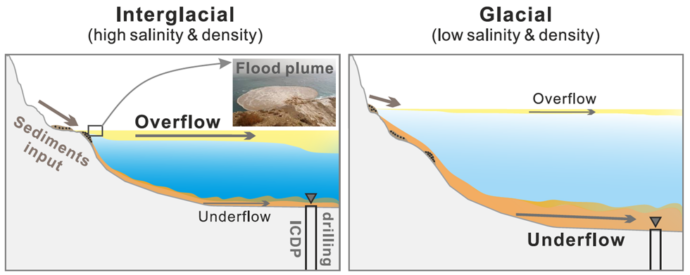This is the latest list of papers on paleoseismology and related fields. This time we have a lot of new studies on Eastern and Central Asia – very interesting reads! Enjoy reading and let me know if I have missed something.
morePosts in the category » « ( 302 Posts )
-
New papers on paleoseismology, active tectonics, and archaeoseismology (Sep 2022)
-
New papers on paleoseismology, active tectonics, and archaeoseismology (Aug 2022)
-
Insights into sediment flow processes can help to better understand the feasibility of turbidite as an earthquake indicator in a specific subaqueous environment
2022-07-23 | in Paper
We investigated homogeneous muds, turbidites, and debrites that were preserved in a 457-m deep ICDP drilling (220-0 ka) from the Dead Sea depocenter. Based on previous flash flood measuring, surface plume monitoring, and sediment traps monitoring in the lake center, we link homogeneous muds in the deep core to overflows, and link turbidites and debrites to underflows. The study bridges the gap between our understanding of modern sediment density flow processes and deposits preserved in a long-term geological record in the Dead Sea, a tectonically active subaqueous environment (Dead Sea rift zone).
more -
New papers on paleoseismology, active tectonics, and archaeoseismology (July 2022)
2022-07-04 | in Paper | one responseThis time I found a lot of studies on tsunamis, including a whole book on tsunamis that affected the Iberian Peninsula. Then there’s classical paleoseismology of course and tectonic geomorphology, but also some discussion on science communication and news about earthquakes in the European Alps. Enjoy reading!
more -
New papers on paleoseismology, active tectonics, and archaeoseismology (June 2022)
2022-06-01 | in PaperAs Francesca has reported in her latest post, a lot of trenching is currently going on all around the world. Here you can read about previous trenching results that have now made it through review. Enjoy reading and have a great field season!
more -
New papers on paleoseismology, active tectonics, and archaeoseismology (May 2022)
2022-05-02 | in PaperOur paper list is full of classic paleoseismic trenching studies from all over the world – fascinating to see how quickly the number of trenches is rising. We also have papers on tools & methodology, and on earthquake proxies that open new possibilities to study past large events. Don’t miss Ferrario et al. who compiled 15 years of research on earthquake environmental effects!
more -
Paleoseismology & the new Hungarian NPP Paks II
2022-03-08 | in Opinion | one responseHungary plans to build a new nuclear power plant (NPP) at the banks of the Danube near Paks, where another NPP is already running for several decades. An interesting story is currently unfolding around the geological site conditions, and this story includes paleoseismology. In short, the Austrians and external experts argue the planned NPP Paks II will sit on a capable fault, while the Hungarians say there is a fault, but it can’t rupture the surface. Actually, it’s a bit more complicated…
more -
Call for paleoseismology & neotectonics sessions at the XXI INQUA Congress 2023 in Rome
2022-03-03 | in MeetingINQUA’s XXI congress will take place in Rome in 2023. This is the most important gathering for the Quaternary community, taking place every four years only. Active tectonics, paleoseismology and related fields have found their home in INQUA’s TERPRO Commission (Terrestrial Processes, Deposits & History). TERPRO provides support for scientific meetings and networking; they have always been involved in the PATA Days and supported dozens of early career researchers and researchers from developing countries with travel grants for these meetings. If you want to support the earthquake community within INQUA, please join TERPRO here. It’s free and comes without obligations. It only means you’ll receive the INQUA newsletters, you can apply for funding for meetings and workshops (as an organiser), and you can elect the TERPRO officers.
Currently, the organising committee of the INQUA Congress in Rome is accepting session proposals for the 2023 congress. Please make sure your areas of interest are represented at the conference. If in doubt, contact your TERPRO officers. Let’s present some great earthquake science at INQUARoma2023!
-
New papers on paleoseismology, active tectonics, and archaeoseismology (Mar 2022)
2022-03-01 | in PaperThese are the latest papers on paleoseismology, active tectonics, and archaeoseismology. Don’t forget to save the date for the Pata Days in France: 26-30 September, 2022. http://pata-days.org/
more -
New papers on paleoseismology, active tectonics, and archaeoseismology (Feb 2022)
2022-02-01 | in Paper | one responseHere we are with the latest list of papers on paleoseismology and active tectonics, and we start with a surprise: A published paper on the 8 January 2022 Ms 6.9 Menyuan earthquake! A mere three weeks after the event, Yang et al. have already managed to get their rapid report accepted. Spoiler: It includes an offset animal footprint trace in snow! But there’s a lot of other interesting stuff in the list, too – check it out!
more
